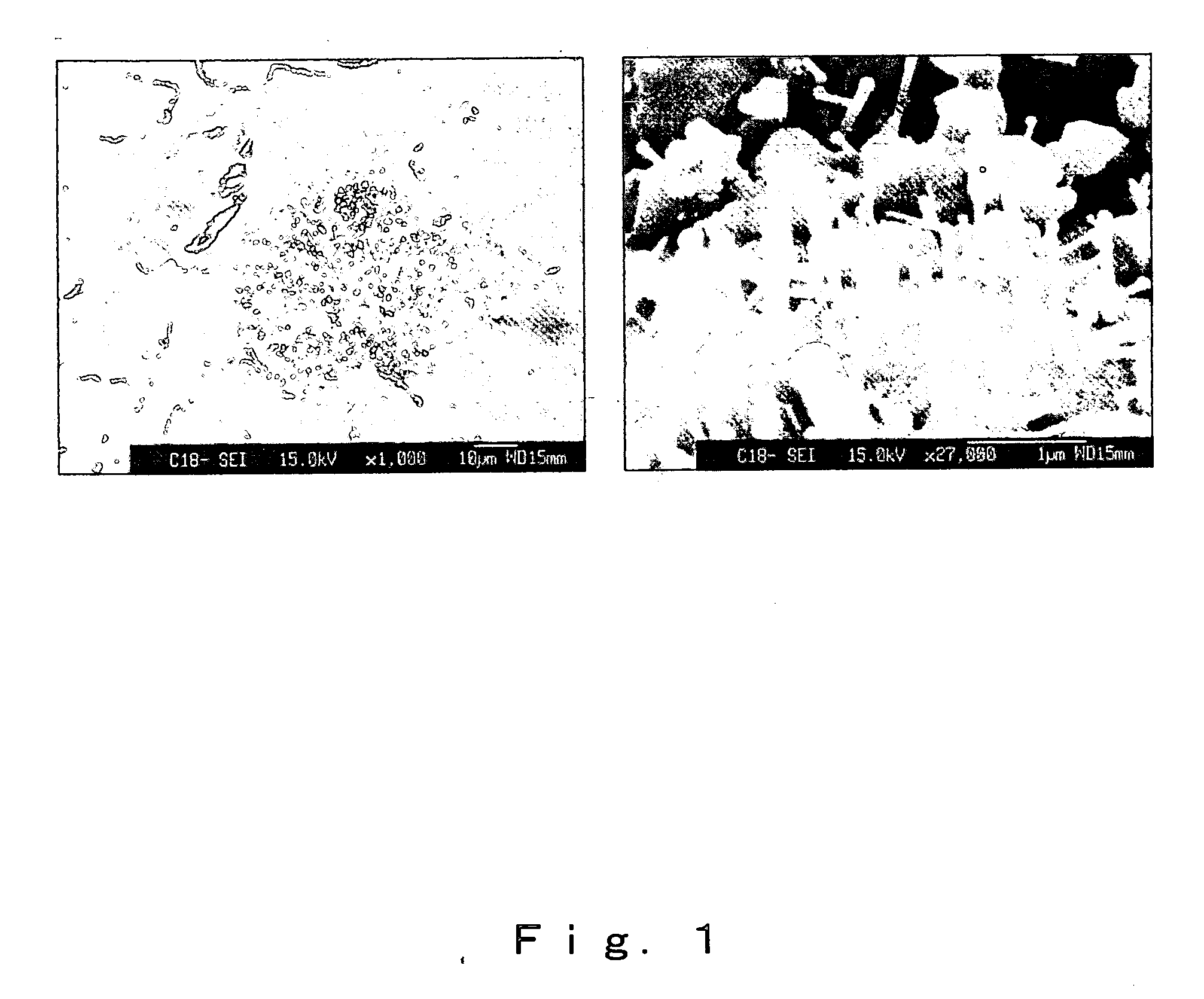Ceramic support capable of supporting catalyst, catalyst-ceramic body and processes for producing same
a ceramic body and ceramic technology, applied in the field of ceramic body of needle-shaped honeycomb catalyst, can solve the problems of increasing the coefficient of thermal expansion of the support, increasing the specific surface area and thermal stability of the cordierite porous body, and difficulty in producing cordierite porous body having a high specific surface area and thermal stability by the conventional method of producing cordierite porous body, etc., to achieve effective utilization of pores, small surface tension, and easy penetration into pores
- Summary
- Abstract
- Description
- Claims
- Application Information
AI Technical Summary
Benefits of technology
Problems solved by technology
Method used
Image
Examples
example 1
[0078] In the present embodiment, a ceramic body having needle-shaped particles was produced from a raw material blended with SrF2. Kaolin (KCM Corp., Japan), talc (Japan Pure Chemical Co., Ltd., Japan), aluminum hydroxide (Al(OH)3, Japan Pure Chemical Co., Ltd.) and silica (silica quartz, d 50 to 0.8 microns, Japan Pure Chemical Co., Ltd., Japan) were used as starting materials. According to a phase diagram of MgO—Al2O3—SiO2, a cordierite phase having a stoichiometric composition (2Al2O3·2MgO·5SiO2) can be formed from a raw material powder. SrF2 was added at 3% by weight to promote the formation of whiskers. The raw material powder was mixed with a ball mill for 24 hours in ethanol. After drying the mixed slurry at 75° C. with a rotary evaporator, the dried slurry was additionally dried in a drying oven at 110° C. The dried powder was then crushed and passed through a sieve having a pore size of 100 microns. This powder was molded with a metal mold at 100 MPa to obtain a pellet-sha...
example 2
[0079] When the structures of pellets burned at respective temperatures after changing the burning temperature were observed, those pellets burned for 4 hours at 1350° C. or higher demonstrated prominent whisker formation. Based on the results of observing the pellet structure, the formation of whiskers was presumed to have occurred by a VLS mechanism. A typical example of the structure is shown in FIG. 1. As a result of EDX analysis, the whiskers were determined to have a cordierite composition. In addition, iron was determined to be contained in the tips of the whiskers. As a result, the impurity iron contained in the kaolin was presumed to have fulfilled the role of a metal catalyst that promotes whisker formation. This is because SrF2 reacts with Al2O3 and SiO2 to form AlOF and SiF4. Due to the high vapor pressure of AlOF and SrF2, crystals grow directly on the metal catalyst. As a result of this process, a vapor containing F formed from decomposed SrF2 is thought to be related ...
example 3
[0080] A honeycomb was fabricated by an extrusion molding process using the same components as Example 1. As a result of cutting out a test piece from the resulting honeycomb and observing with a scanning electron microscope (SEM), needle-shaped bodies were formed on the surface in the same manner as the case of having molded into pellets, and on the basis of the results of EDS analysis, Si, Mg and Al were detected, thereby demonstrating that the resulting honeycomb was cordierite.
[0081] In the case a portion of a gasified raw material was used to grow needle-shaped particles on a metal catalyst, the increase in specific surface area was observed to be several times to several tens of times that of a base material on which needle-shaped particles are not formed. This is because of the increase in the catalyst loading surface area on the surface of the particles resulting from making the tips of the needle-shaped particles spherical. In addition, since the tips of the needle-shaped ...
PUM
| Property | Measurement | Unit |
|---|---|---|
| width | aaaaa | aaaaa |
| aspect ratio | aaaaa | aaaaa |
| specific surface area | aaaaa | aaaaa |
Abstract
Description
Claims
Application Information
 Login to View More
Login to View More - R&D
- Intellectual Property
- Life Sciences
- Materials
- Tech Scout
- Unparalleled Data Quality
- Higher Quality Content
- 60% Fewer Hallucinations
Browse by: Latest US Patents, China's latest patents, Technical Efficacy Thesaurus, Application Domain, Technology Topic, Popular Technical Reports.
© 2025 PatSnap. All rights reserved.Legal|Privacy policy|Modern Slavery Act Transparency Statement|Sitemap|About US| Contact US: help@patsnap.com


